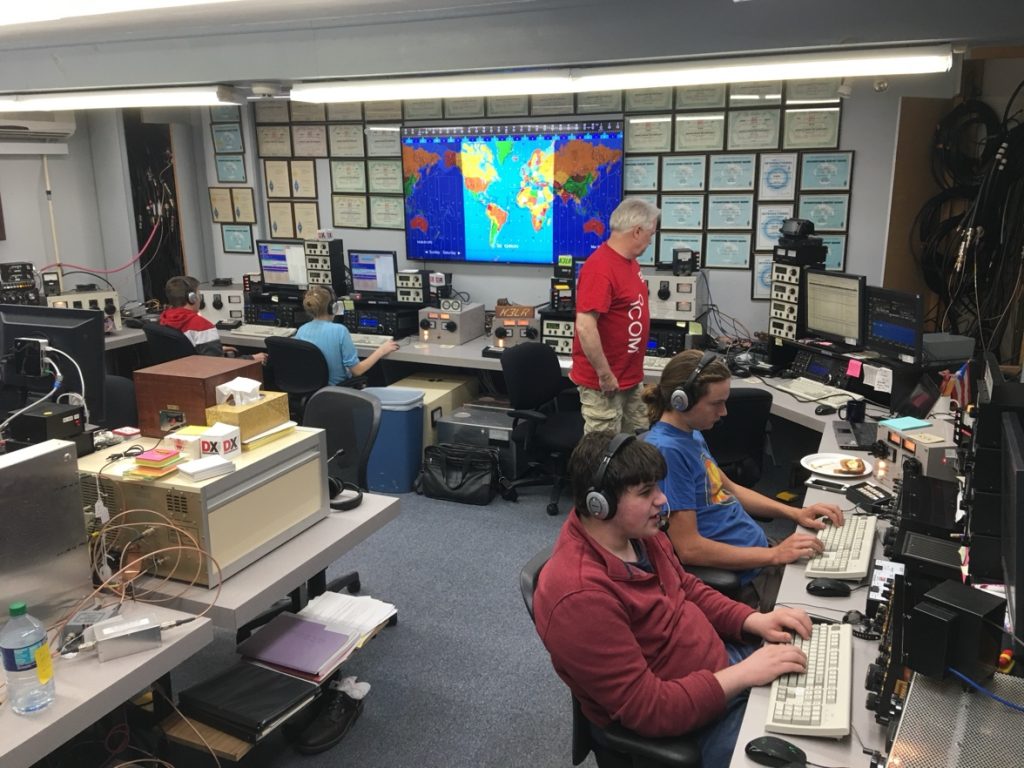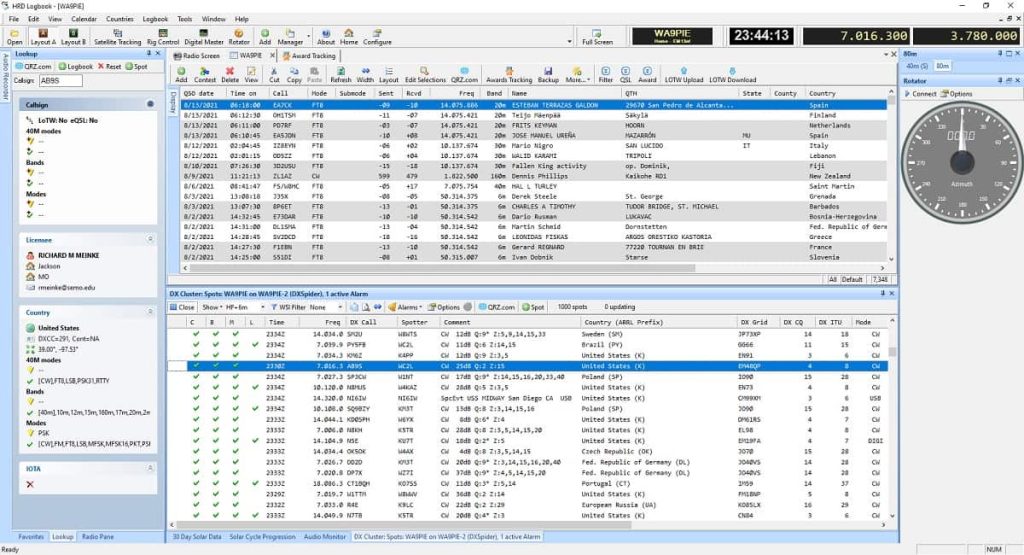Editor’s note: OnAllBands is pleased to post a series of articles written by accomplished amateur radio contester and DX Engineering customer/technical support specialist Kirk Pickering, K4RO. The articles, originally published in the National Contest Journal and updated with current information, offer valuable insights for both contesters new and old.
***
Hello again and welcome back to Contesting 101. Perhaps some of you are making plans to attend 2025 Dayton Hamvention® May 16-18. I plan to attend this year, and I hope to visit with many of you over the weekend. The contesting community is of great importance to me, so we will begin this column with a discussion of contest clubs. Please don’t hesitate to ask questions in the comments section below.
Contest Clubs
Contesters are a peculiar breed of Homo sapiens. It takes a special kind of person to sit in front of a radio for an entire weekend, with relentless static and QRM pounding in one’s ears. Only contesters understand the joys and perils of contest operating, and this understanding forms a common bond among us. There are few things more enjoyable than sharing a passion for something with like-minded individuals. I have laughed until tears flowed while sharing some of the hilarity and absurdities of contest operating with my fellow ops. I’ve also shared tough disappointment and heartbreak with some of them as well. Our bond as contest operators is a special one and should not be underestimated.
One of the best ways to get started developing these bonds is to join a contest club. I suggest a local club where you can meet other contesters face-to-face if at all possible. If geography or other limitations prevent in-person meetings, there are also several “virtual” contest clubs in which you can participate. I was fortunate to have started contesting right at the same time that the Tennessee Contest Group (TCG) was forming. We had monthly breakfast meetings, and we would gather at hamfests around the state. The early TCG meetings were my first exposure to contest operators off-the-air. The first thing that really struck me was the passion and endless enthusiasm that these folks demonstrated. The second thing that struck me was that I was not alone.
Despite my intent to “never belong to a club that would have me,” I found a place where I actually did belong.
Here is a list of amateur radio contest clubs from the ARRL.

Join a Team
If there is not an active contest club in your area, there are other ways to join up with your fellow radio enthusiasts. There are several contests which offer team competition, and some events such as the NCJ North American Sprint and North American QSO Parties (NAQP) have no geographic boundaries on teams.
Contributing your score to a team or club effort is an excellent way to start forming connections with other contesters. Team competition can also improve your operating skills. Operators often find themselves trying a little harder and staying in the chair a little longer when they know that their teammates are depending on them. Many of the larger contests also offer club competition, where all of the scores for a club are combined to form an overall club total. The competition for club gavel honors can be quite intense, and every score really counts toward the final tally. Another great way to meet contesters is to offer to participate in a multi-op. Multi-ops are a great opportunity to learn operating skills, and you might even make some new friends as well.

The point is to get involved at some level and discover the joys of sharing our passion. Dayton Hamvention is probably the largest in-person gathering of contesters that you’ll find and is an excellent opportunity to put some faces on calls. For those in the western half of the country, the International DX Convention in Visalia, California, is also well-regarded. Take some time to meet your fellow contesters. You might find that you’re not alone!
Tuning the Bands
With rare exception, every contest operator usually begins making contest QSOs by tuning the bands and answering stations who are calling CQ. We refer to this type of operating as “Search and Pounce” or S&P. Effective S&P skills are developed with lots of practice. Calling CQ or “running” is also very important, and we will cover running stations in a future column. Since most operators begin contesting by searching and pouncing, we will begin our discussion there.
One of the first things that a contest operator must learn is how to tune a band and identify signals. Consider that a relatively inexperienced operator might scan a band for thirty minutes and, perhaps, find a dozen stations that they are capable of putting into the log. An experienced and skilled S&P operator at the exact same station with the same conditions will find two to three times as many stations and put them in the log in the same amount of time.
How is this possible? The experienced operator is able to identify stations more accurately and more quickly, and they can hear further down into the noise. Identifying stations more quickly is important because as we said in my first Contesting 101 column, it’s us against the clock. Hearing further down into the noise increases the number of stations (and multipliers!) that we can work.
When I entered my first contests, I just spun the dial at random, calling the loudest and clearest signals after identifying their call signs. After a short time, it would seem as though I had worked every signal on the band, and I just kept hearing the same stations over and over. The problem with the random tuning approach was that I kept covering the same band segments, while skipping over and missing many stations in the process. I usually find it more productive to start at one edge of the band and tune continuously to the other edge of the band. My preference is to start at the highest frequency that I can find contest activity, then tune carefully to the very bottom of the band. I work every valid station that I can identify and then continue tuning in the same direction until I encounter another signal.
A band map is a feature included in many contest logging programs. It is a visual representation of a band, showing the stations that you have worked in order of frequency. Using a band map can speed up search and pounce operation by showing us “where we have already been” on the band. A band map will also reveal gaps where we might have missed someone who was not transmitting as we tuned by.

Time is of the Essence
There are several things that we can do to speed up the identification of stations. Let’s take the NCJ North American QSO Party contest as an example. Imagine that we are tuning a band for the first time, and therefore every station that we hear calling “CQ Contest” is a new potential contact. We might simply start at one end of the band and tune from top to bottom, working every station that we can copy along the way. One thing that becomes immediately obvious is that some stations are calling CQ, while others are answering CQs. We can speed things up by learning to distinguish which is happening on a frequency, as quickly as possible.
For example, if we hear a call sign sent (W9WI) and then a different signal sends the same call (W9WI) and then a contest exchange, we already know which station is calling CQ. Here is a hint–it’s not W9WI. Without having even heard the CQing station’s call sign yet, we know that we’ll have to wait for:
- The CQing station to finish sending their exchange to W9WI
- W9WI to confirm the report and send their exchange
- The station to QSL W9WI and call CQ again
If we are lucky, they will call CQ and include their call sign properly. If we are unlucky, we just might hear TU or QRZed, and then another pileup.
Depending on conditions, we might have been better off storing the frequency in a memory location or band map and then tuning further to find someone just sending their call and ending a CQ. Why? Because we can answer a station who just finished calling CQ immediately, without any waiting.
When we’re finished with that QSO, we can punch our memory button (or click on our band map) and return to the station that W9WI was working. If our timing is good, we just might find that station sending their call sign and finishing a CQ, in which case, we would drop our call immediately and make another QSO. In the time that we might have spent waiting for a station to identify, we have managed to “sneak in” another QSO. This is one example of how we can work more stations per hour while Searching and Pouncing.
Hearing the Weak Ones
Learning to listen further down into the noise is a skill that can increase the number of potential QSOs available on a band. As contest operators, we need to expand our idea of what is possible to discern with our ears and brain. I recommend listening to some of the recordings that CN2R or K5ZD have made available on the Internet. You will hear completed QSOs that will sound like pure noise or QRM to the casual listener. The seasoned radio operator can distinguish call signs and exchanges under incredibly adverse conditions. Like all contesting skills, there is no substitute for practice. Whether using an indoor vertical or a huge phased array, the contest operator must work many stations right at the noise floor.
It takes time for one’s ears to become accustomed to copying very weak signals. DXers and weak-signal VHF operators will already have some experience in this area. We can train our ears during non-contest times simply by tuning our receivers to the weakest signals that we can find, day or night. Hearing the weak signals becomes even more important when we start calling CQ because we have no control of the strengths of the signals which may answer. CQing stations typically have to answer many weak signals, particularly if they are loud. We’ll cover this subject in more detail in a future column on calling CQ.
No Guessing!
Another habit to get right from the start is to avoid the temptation to guess. When working weak signals, we need to learn to distinguish fantasy from reality. Most contests these days reward accuracy and penalize logging errors. The advent of computer log checking coupled with penalties for busted QSOs means only one thing—no guessing allowed! We either can complete a QSO or we cannot.
If we are unsure, then we have to err on the side of caution and ask the station to try again. Sometimes we just cannot complete a QSO, and the only thing left to do is to move on. It can be tough. Perhaps a rare double multiplier or “clean sweep” might be hanging in the balance. We might have to come back later when we won’t have to rely on extra sensory perception to complete a QSO.
If you cannot complete a QSO despite repeated attempts, try hard to let the other station know that they are NOT IN THE LOG. Usually I will say something like “SORRY NO QSO. NOT IN LOG. PLEASE TRY AGAIN LATER.”

